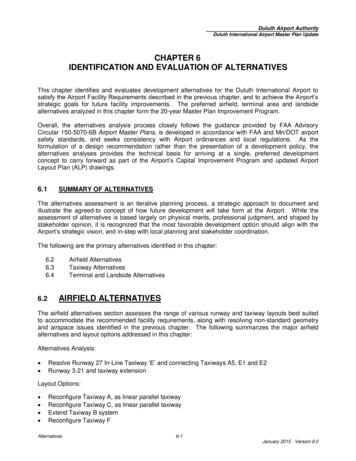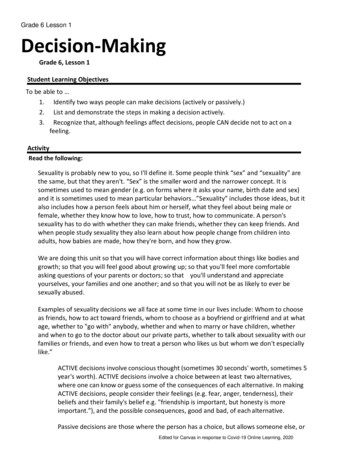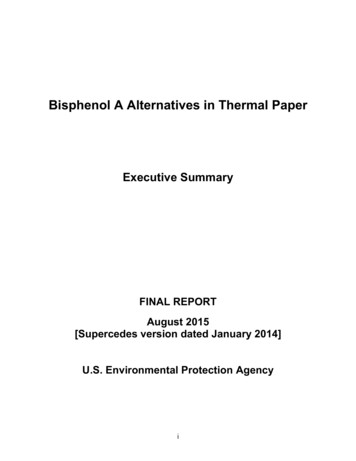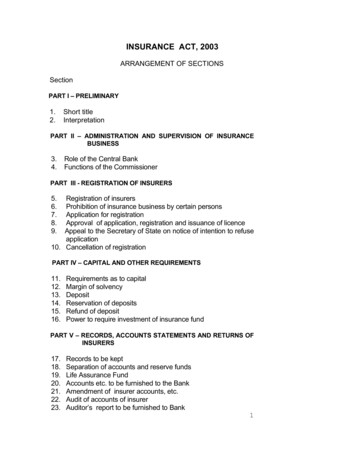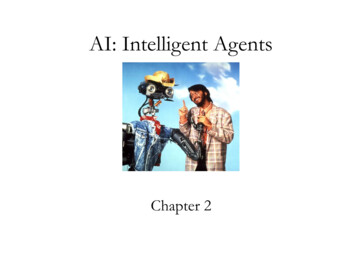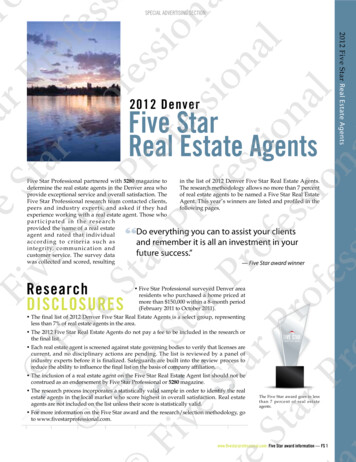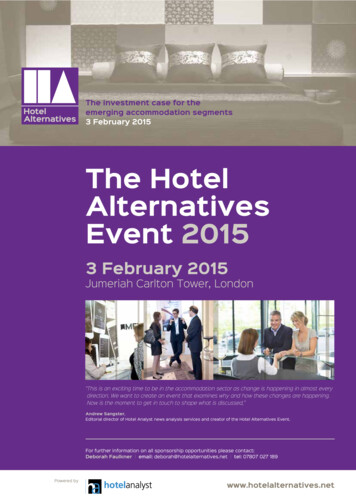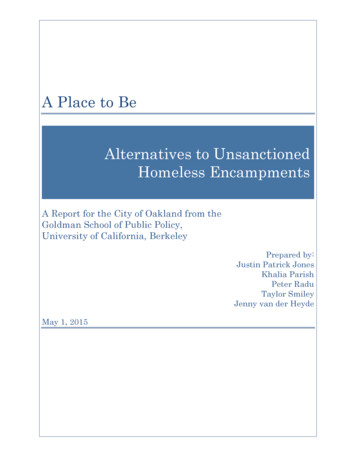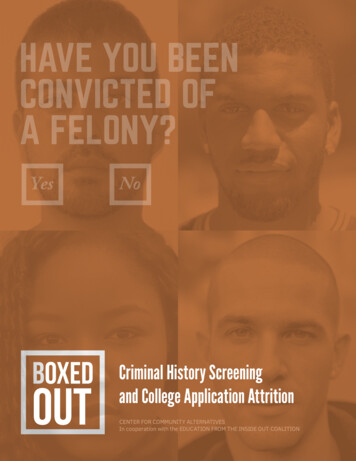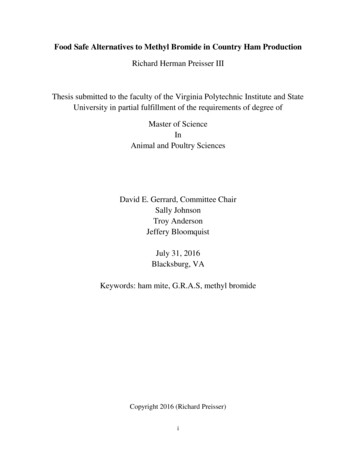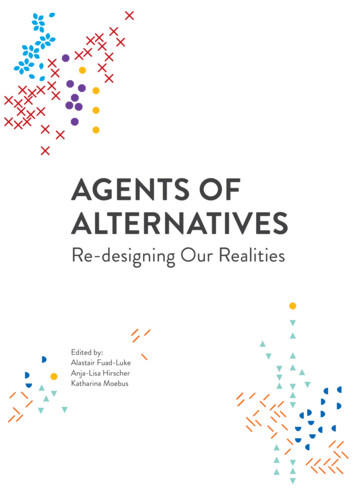
Transcription
Agents ofAlternativesRe-designing Our RealitiesEdited by:Alastair Fuad-LukeAnja-Lisa HirscherKatharina Moebus
Agents ofAlternativesRe-designing Our RealitiesEdited by:Alastair Fuad-LukeAnja-Lisa HirscherKatharina Moebus/500Agents of Alternatives (AoA), Berlin, Germany
First edition produced and published byAgents of Alternatives, Berlin, Germany in May 2015Edited by: Alastair Fuad-Luke, Anja-Lisa Hirscher, Katharina MoebusThis work, copyright 2015 Agents of Alternatives and the individual contributors, is licensed under a Creative Commons Attribution-NonCommercial-ShareAlike 4.0 International, available here http://creativecommons.org/licenses/bync-sa/4.0, with the exception of the essay by David Bollier, which is reproducedhere from his book Think Like A Commoner with kind permission from NewSociety Publishers, copyright 2014Visual concept & cover: Anja-Lisa Hirscher and Katharina MoebusEditorial design: Anja-Lisa HirscherPage layout: Anja-Lisa Hirscher and Gaspar MostafaBritish-English proofreading: Isabelle Machado AiresTranslation: German to English by Katharina MoebusFont: Brandon Grotesque and Aleo, which is licensed under the SIL Open FontLicense, Version 1.1Printed by InPrint, Latvia, 2015. The paper is Multi Design Original Natural,Forest Stewardship Certified (FSC)ISBN: 978-3-00-049379-9 paperbackAgents of Alternatives e.V.Berlin, Germanywww.agentsofalternatives.comAgents ofAlternativesRe-designing Our Realities
ACKNOWLEDGEMENTSMany people and organisations helped make this book a reality. We give a particularly warm thanks to our contributors who generously gave their time andenergy to share their experiences and thoughts. We extend our grateful thanksto our crowdfunding sponsors who funded some of the key production costs via acampaign on Sponsume. We thank them for their trust and patience throughoutthe project. Some of them, as page or content sponsors, also contributed thoughtsand words, which we think enriches the content of the book.We thank the Finnish Cultural Foundation (SKR, Suomen Kulttuurirahasto) forfunding the early stage research from September 2012 to September 2013. Also, wewish to acknowledge Aalto ARTS (The School of Arts, Design & Architecture, AaltoUniversity), Helsinki, Finland for the research and writing time we were able todedicate to this project. Alastair extends his thanks to Lahti Region Development(LADEC) Finland for funding received through Aalto ARTS under the Elite 2 project,and to Riikka Salokannel, Design Development Director, with whom he workedfrom 2011 to 2014. The editorial team acknowledges the support of Professor PirjoHirvonen, Head of the Design Department at Aalto ARTS during that period.We are very grateful to Gaspar Mostafa for his significant contribution to thepage layout design and for converting raw diagrams into stylish graphics; to IsabelleMachado Aires for the eagle-eyed dedication she brought to British-English proofreading; to Cathérine Kuebel for her contribution in the early phase of the researchand to the two workshops we held in Berlin in October 2013 and February 2014.We give sincere thanks to the founding members of the non-profit associationAgents of Alternatives agreeing to publish this book as one of its first activities. Inaddition to the editors of this book, our co-founding members are Malin Bäckman,Nicholas Torretta, Gaspar Mostafa, and Peter Breuer. We thank our lawyer JuliaBreuer for her advice during the formation of the organisation and Tabea Glahsand Sanneke Duijf for their input during the organisation's early developmenttogether with Daphne Büllesbach and Cecilia Palmer for their experienced advice.Warm thanks to all the contributors who penned something for the book, and toall the named and un-named contributors to the projects we featured:Amber Hickey, Ana Malalan, Andreas Unteidig, Andrew Paterson, Anna Richter,Antonia Schui, Ben Becker, Ben Pohl, Bernd Kniess, Bianca Herlo, Caleb Waldorf,Cecilia Palmer, Christina Nägele, Christopher Laumanns, Cindy Kohtala, ClaudiaGarduño, Cordula Andrä, Corinna Fuchs, Daphne Büllesbach, David Bollier, David4Griedelbach, Diana Krabbendam, Elisa Garrote-Gasch, Eric Schuldenfrei, FionaGeuß, Florian Sametinger, Fotini Lazaridou-Hatzigoga, Francesca Weber-Newth,Frauke Hehl, Frigga Haug, Gabi Sobliye, Gesche Joost, Harald Gruendl, Isolde Nagel,Jennifer Schubert, Joel Rosenberg, John A. Harris, Lisa Gutermuth, Luisa MariaSchweizer, Malin Bäckman, Malte Bergmann, Marcin Jakubowski, Marco Kellhammer, Marisa Yiu, Martin Parker, Maya Indira Ganesch, Michel Bauwens, Ottovon Busch, Sam Muirhead, Samantha Riccio, Stefanie Gernert, The Public SchoolBerlin, Thinkfarm, Tiina-Kaisa Laakso-Liukkonen, Trade School New York, ValerieA. Brown, Wendy Brawer and Zoe Romano.Sponsors:Adam de Eyto, Aita Bott, Anna-Miia Suihkonen, Anne Badan, Antti Vaahtersalo,Caroline Lutteri, Carolyn Strauss, Christopher Barlow, Claudia Garduño García,Colin Webb, Daphne Büllesbach, Fahrettin Ersin Alaca, Fernando Lusitano, GasparMostafa, Graham Hill, Helge Mahne, Inês Laranjeira, Ingeborg Zimmermann, J.E. Frost, Jakub Bobrowski, Jenni Väänänen, Jessica Walsh, Julian Lindley, KirsiNiinimaki, Kristiina Karinen, Larry Hickey, Liam Hinshelwood, Lucero Donaji dela Huerta, Merced Gómez, Malin Bäckman, Matei Cioata, Matti Jäppinen, MichaelMoebus, Mike Waller, Mima Pejoska, Ying-Ju Lin, Paula Bello, Peter Breuer, Rebekka Moebus, Lili de Larratea, Ricardo Gonçalves, Sakari Karinen, Sarah Johnson,Selçuk Balamir, Siegfried Hirscher, Susanne Bergner, Suvi Kajamaa, Svetlana Usenyuk, Tabea Glahs and Tom White.We would like to extend further personal thanks:Alastair: I am grateful to all my friends, family, co-editors, students and colleagueswith whom I’ve shared many conversations during the preparation of this bookand who helped me turn emergent thoughts into words.Anja: I would like to thank everyone from my family and home in the Allgäu —my dear friends there — for inspiring walks and talks, plus my friends, colleaguesand co-editors in Helsinki and elsewhere, for great discussions and support allalong the way.Katharina: My dearest thanks to my love Peter and our little daughter Ofelia, tomy family, old friends and new ones made through this book, my co-editors Anjaand Alastair, colleagues and co-activists from Helsinki, Berlin and elsewhere for allthe inspiring discussions and perspectives that helped make this book.5
the contributorsThe contributors to this book come from diverse fields including architecture, art, design,landscape architecture, urban planning, education and research, to name a few. They are practitioners, activists, designers, artists and academics. This book would not have been possiblewithout their commitment to challenging the paradigm and their belief in creating alternatives.6Frauke HehlFrigga HaugGabi SobliyeGesche JoostHarald GruendlAlastair Fuad-LukeAmber HickeyAna MalalanAndreas UnteidigAndrew Gryf PatersonJennifer SchubertJoel RosenbergJohn A. HarrisKatharina MoebusLuisa Maria SchweizerAnja-Lisa HirscherAnna RichterAntonia SchuiBen BeckerBen PohlLisa GutermuthMalin BäckmanMalte BergmannMarcin JakubowskiMarco KellhammerBernd KniessBianca HerloCecilia PalmerChristina NägeleChristopher LaumannsMartin ParkerMaya Indira GaneshMichel BauwensOtto von BuschSam MuirheadCindy KohtalaClaudia GarduñoCordula AndräDaphne BüllesbachDavid BollierStefanie GernertThe Public ade SchoolNew YorkDiana KrabbendamElisa Garrote-GaschEric Schuldenfrei &Marisa YiuFlorian SametingerFrancesca WeberNewth & Isolde NagelValerie A. BrownWendy Brawer &Samantha RiccioZoe Romano7
contentsIntroductionHow to use this bookAlternative worldsMap of contributionsAn evolving lexicon1216182022Case StudiesAalto Lab Mexico by Claudia Garduño (ALM)Women’s Rights Campaigning: Info-Activism Toolkit by Maya Indira Ganeshand Lisa Gutermuth, Tactical Technology Collective (WRC/TTC))InterjectionStarting a Trade School by Trade School New York (TS)THINKINGEssays’Hacking in the name of ’: Agents of Alternatives and Virtuous Vigilantesby Otto von Busch (OvB)A collective mind for a just and sustainable futureby Valerie A. Brown and John A. Harris (VBJH)InterviewsAmber Hickey, A Guidebook ofAlternative Nows (GAN)Daphne Büllesbach & Luisa Maria Schweizer, European Alternatives (EA)Tiina-Kaisa Laakso-Liukkonen, Design Driven City (DDC)Case StudyTools for the Design Revolutionby Institute of Design Research Vienna (IDRV)11612813838404658667886SHARINGEssaysThe Commons as a Different Way of Seeing and Being by David Bollier (DB)Are there Alternatives beyond the market? by Michel Bauwens (MB)140142158InterviewsMaya Indira Ganesh and Gabi Sobliye, Tactical Technology Collective (TTC)Cecilia Palmer, Open Fashion & Code (OF)172182Case StudiesOpen Green Map by Wendy E. Brawer with Samantha Riccio (GM)Pixelache Festival by Andrew Gryf Paterson (PA)Satokartta by Joel Rosenberg (SK)OpenWear - Collaborative Clothing by Zoe Romano (OW)19020021422094LEARNINGEssaysLearning by doing - the transformative power of do-it-together (DIT)by Katharina Moebus (KM)InterviewCaleb Waldorf, Fotini Lazaridou-Hatzigoga and Fiona Geuß,The Public School Berlin (PS)896108MAKINGEssaysSystems of Resilience: A dialogue on digital makers, making and theirprinciples of conduct by Cindy Kohtala (CK)The Joyful Experiences of Making Togetherby Anja-Lisa Hirscher (ALH)2282302409
InterviewsMarcin Jakubowski, Global Village Construction Set &Open Source Ecology (GVCS)Elisa Garrote-Gasch, Repair Café Berlin (RC)Case StudyMake{able} - Valuable clothes designed together by Anja-Lisa Hirscher (M)INTERVENINGEssaysDesign activism’s teleological freedoms as a means to transform our habitusby Alastair Fuad-Luke (AFL)268278280296Case StudiesBring Your Own Biennale by Eric Schuldenfrei and Marisa Yiu (BYOB)Neighbourhood Labs by Design Research Lab, Berlin University of the Arts (NL)310322WORKINGEssaysThe 4-in-1-perspective by Frigga Haug (FH)The architect and the bee revisited: Managing, organising and agencyby Martin Parker (MP)InterviewsFrauke Hehl and Antonia Schui, workstation ideenwerkstatt e.V. (WS)David Griedelbach and Corinna Fuchs, Thinkfarm (TF)372382Case StudiesAnselma: The ‘everything is possible‘ public studio by Ana Malalan (A)Konzeptwerk Neue Ökonomie by Christopher Laumanns (KNÖ)388396258InterviewDiana Krabbendam, The Beach (TB)InterjectionDesigning with(in) a community: Sharing insights gained through practiceby Malin Bäckman (MB)10250LIVINGEssayUniversity of the Neighbourhoods – Hotel as Method? by Benjamin Becker,Stefanie Gernert, Bernd Kniess, Ben Pohl, and Anna Richter (UdN)InterviewsCordula Andrä, Centre for Experimental Cultural and Social Design (ZEGG)Francesca Weber-Newth & Isolde Nagel, Community Lover’s Guideto Berlin (CLG)406408430440Case StudyYear of Open Source by Sam Muirhead (YOS)450PRACTICES & REFLECTIONSStuff that worksAfterthoughtsFurther readingEndnotes46046247647848033835035236211
introductionYou hold in your hands a book which is really a manifestation of an evolving vision to link designing with everyday ‘active-ism’ which helps materialise plausible‘alternatives’ to the global economy and neo-liberal capitalist practices. This wasdriven by an underlying belief that we need to ‘re-design our realities’ to betterreflect and respond to our pressing contingent challenges about our social, ecological and financial condition.Exploring ‘agents of alternatives’ demands a multidisciplinary dialogue withinand between citizens, practitioners and academics who make things happen. So, youwill find contributors from diverse fields: design, the arts, architecture, education,politics, economics, urban planning and city administration, social enterprise andthe informal sector, including non-governmental organisations (NGOs), experts onthe commons, and others. We encouraged activists, researchers, educationalists,strategists and facilitators to share their views. In this book we mix the voices ofwell-known contributors alongside lesser-known active local agents. We look foremergent ways of learning-by-doing, of designing, of manifesting things differently and catalysing positive change, and we present these ways of thinking andpracticing so that others might fruitfully experiment with, explore and generatealternatives for themselves.AgencyOur position is that everyone and everything has agency, that is, the capacity tochange what happens next. A position reinforced by certain philosophers – forexample, Bruno Latour’s human and non-human ‘actants’, Gilles Deleuze and FelixGuattari’s ‘social material assemblages’, and Jane Bennett’s ‘vibrant matter’.1 We,and our contributors, also adopt more accepted sociological and anthropologicalviews of agency involving the social structures, systems and rules which bind orbreak them. Those with agency are actors, stakeholders, shareholders, institutions, organisations, diverse communities and other social groups. We would alsoinvoke ‘political agency’ as a healthy form of disagreement and discourse as partof our civic and human condition, not confined within formalised institutionalisedpractices of ‘politics’. In this sense we see the political agency of this book and its1 See, for example, Latour, B., 2005. Reassembling the Social. An introduction to Actor-Network-Theory. Oxford: OxfordUniversity Press; Deleuze, G. and Guattari, F., 1987. A Thousand Plateaus: Capitalism and Schizophrenia. Trans. BrianMassumi. Minneapolis: University of Minnesota Press; and Bennett, J., 2010. Vibrant Matter. A political ecology ofthings. Durham, USA: Duke University Press.12contributors as a means to re-examine and explore our social relations and ourrelations with the wider world so that we might, individually and collectively positor construct alternatives.The agentsWho are these agents of alternatives? They exhibit some common features: they areindependently minded, but share a critical awareness of our social, ecological andeconomic condition; they have a vision but it is adaptive to changing circumstances;they are open and transparent, showing their processes and sharing their expertise;they start their journey with the (often meagre) resources at their disposal andshow perseverance; they believe their voice counts and encourage others to addtheir voices too; they turn rhetoric into action; and they reveal opportunities andpossibilities. Most importantly, all our contributors here are ‘making things happen’,they are active not passive, caring not distant, and different not conformist. Readtheir voices in the essays, interviews and case studies.AlternativesAnyone, or anything, contesting the status quo, societal ‘norms’ or contemporaryparadigmatic forces, is, potentially, an ‘alternativ-ist’. To be an alternativ-ist is nota new position but has an illustrious history which embraces daring individuals,collective movements, specialised groups and minorities.2 Here we define our alternatives through a series of imagined worlds –Thinking, Learning, Sharing, Making,Intervening, Working, and Living – worlds which evolved as the content for thebook grew (see p.18-19). We see these worlds intertwined, joined by a series of emergent practices (p.462) and expressed through an evolving lexicon (p.22-37). Thesealternatives are still young, yet they are potentially catalytic and, if scaled-up, canencourage a transition towards more sustainable, equable and adaptable futures.We found professionally organised alternatives that try to bridge policy-makingand grassroots activism as well as small initiatives that have spread all aroundthe world, because their underlying ideas are so simple, accessible and welcomingto a wide range of people. There are different ways of changing society, and thisbook tries to have a closer look at the potential of the informal and formal worldsof change makers.Re-designingOur shared vision for this book was also underpinned with a belief that the field ofdesign is diffusing out into wider society and is no longer just the primary concernof professionally trained designers, but is actually being practiced by other profes-2 Parker, M., Fournier, V. and Reedy, P., 2007. The Dictionary of Alternatives: Utopianism and Organisation. London:Zed Books.13
sionals, professional amateurs and citizen designers. We share and update VictorPapanek’s view that ‘all people are designers’,3 and Joseph Beuys’ political positionmaking all citizens ‘artists’ that shape the ‘social sculpture’ of our society.4 And, webelieve that a sustainable way of designing is to work with what is existent in a‘locale’5 – a diverse array of human, social, public, commercial and natural capitals.In this sense ‘re-designing’ makes more sense than ‘designing’, because it involvesre-configuring the potential of what already exists. This might, of course, involvebringing in new ingredients and smartly combining them to create fresh potentialities. The initiatives, projects and ideas collated in this book are representative fora growing global ‘zeitgeist’ (spirit of the time) around openness and sharing. Thismeans making ideas accessible to everyone so that they can be adapted to diverselocal conditions. Most of them are open source so individual authorship becomesless important and the positive impacts and potentialities of sharing are emphasised. They bring different communities and places around the world together ina dynamic self-organised and, often, surprising way.To summarise, it is our hope that this book will stimulate you, the reader, to becomean agent of alternatives too 3 Papanek’s original quote was ‘All men are designers’, p.17 in Papanek, V., 1974. Design for the Real World. HumanEcology and Social Change. St. Albans, UK: Paladin.4 See, for example, http://en.wikipedia.org/wiki/Social sculpture and http://www.social-sculpture.org5 ‘Locale’ has an etymological root in ‘locus’, Latin for place, and is a French word defining local. More importantly,locale, is a combination of unique ingredients or characteristics which differentiate what it means to be local. Localeis a scalable phenomenon that, like the famous Charles and Ray Eames’ film Powers of Ten, can be felt at many scalesfrom one square metre to a hectare or more. It is also a meeting place of various communities, it is the location ofspecific human ecologies. So each locale has a unique combination of communities of place, communities of practice,communities of interest and communities of circumstance and other types of communities. Source: Fuad-Luke, A.,2012. Locale. Window874, available at http://window874.com/2012/05/29/locale14Editors' notes: We added editors' footnotes to interview and case study texts wherewe thought it would assist the reader. In the essays these are marked as such, todistinguish them from the original contributor's footnotes.15
HOW TO USE THIS BOOKThe founding principle of this book is that the diverse content provided by thecontributors would drive an emergent structure.We came together in November 2013 in Helsinki to analyse the content we’dalready received and to develop the language for the book (Figure 1.). We believed,and still believe, that genuine empowerment happens by locating ourselves withinan alternative framework, by seeing positive disruptions to the status quo, by repositioning what designing can do, and by focusing on Our Commons (we use ‘our’not ‘the’ to emphasise that the default ownership is ‘us’ and ‘we’, not ‘them’) andhow we can share in better ways for the common good.Figure 2. The editors having a ‘eureka’ moment with Cathérine Kuebel in Berlin,February 2014. AoA.tices and have presented them as ‘Stuff that works’ (p.462). These practices rangefrom those based upon eminent common sense to ingenious ways of encouragingtransformation. We hope you will recognise some, and add your own. We also observed that people were talking and writing about their ‘worlds’ and ‘practices’ withnew language, so we created an ‘evolving lexicon’ (pp.22-37). We hope that thesecollated ‘insights’, ‘practices’, ‘emergent words’ and, of course, the detailed contentfrom our contributors, will stimulate you, the reader, to reflect and re-think yourown position. We hope that flipping between this synthesis of the content andthe actual content will provide its own stimulus. In short, we hope that this extrajoining of information at a ‘meta’ level, might provide some magic ingredients togenerate, nourish and sustain alternatives.Figure 1. Some emergent keywords from the editors’ conversation in November 2013. AoA.In February 2014 the editors came together in Berlin to further explore and understandthe content we had already received and do an initial mapping of its relations (Figure 2.).These two meetings led us to create an active vocabulary and initiated a conversation about whether we could analyse and synthesise the content into a moreconstructive and practical arrangement that would inspire. We understood thatpeople were acting and taking action around different focal areas — we calledthese areas ‘alternative worlds’ (see next page). They are/were developing [design]practices that help encourage a transition from the existing situation to a preferredsituation (to borrow from the words of Herbert Simon1). We analysed these prac-16Map of contributionsEach contribution in this book was assigned to a ‘primary’ world with other worldsas ‘secondary’ influences to see how the different projects, initiatives and philosophies interweave and cluster. The outcome is a ‘map of contributions’ (pp.20-21)which allows a different way of navigating through the book and making sense ofits contents. It serves as an addition to the traditional list of contents and invitesyou, the reader, to experience the book in many different ways: non-linearly, according to chapter, interest, theme, format and so on. Enjoy the journey.1Simon, H., 1996 (1969). The Sciences of the Artificial. Cambridge, MA: MIT Press.17
alternative worldsWe believe that alternatives are best created and designed together by thinkingdifferently and making those thoughts tangible by taking action. The diversityof contributions in this book highlights that there are many intertwined worldswith which we can engage. We offer working definitions of these worlds, withoutasserting them to be either final or complete, hoping that you will add your own.We believe that by combining these worlds in different ways, we can ‘re-designour realities’.18Making – the act of bringing a form, process, service orexperience to life, while realising individual and/or collective creative human potential and capital.Thinking – the diverse acts and practices of discursiveactivities, free association, ideation, inquiring, intuiting,philosophising, reasoning, reflecting, ruminating andsynthesising individually and/or collectively as a meansto nourish our human, social and other capitals.Intervening – introducing activities and/or artefactsto engage, by consensus or disruption, to stimulatedialogue and actions towards a common purpose as ameans to better our world.Learning – the activities of acquiring, giving and exchanging skills, knowledge and experiences by teaching oneself and others, and learning from each other toencourage healthy social discussion, evolution of newwisdoms and activation of hidden capabilities.Working – modes of being active, of acting, operating,functioning, organising and practicing to achieve something, to earn or make a livelihood, to be a valued contributor to society, its individual members and to oneself.Sharing – acts, actions or reciprocal relations betweenindividuals, groups and communities to enjoy and enrich something together (time, objects, experiences, etc.)based on respectful mutuality, interdependency, openness and generosity.Living – human activities of alive-ness, being-ness, existences, livelihoods and other ways of being that affectour individual and collective condition, our thriving andflourishing, and our natural, spatial, physical, mental,spiritual and other dimensions of being in the world.19
ThinkingMap of ContributionsThe initials represent the contributorslisted in the contents on p.8 with theirrespective page 338Intervening21
architecture of participation: a phrase coined by Tim O'Reilly that is used to describe the nature ofsystems that are designed to encourage a community of users to contribute to the content, or to thedesign and development process. attainable micro-utopias: a suggestion by design theorist John Wood, that micro-utopias are far moredoable and reachable than grander Utopian projects or visions, and that they can be achieved by applying a holistic conceptual design framework which he calls ‘metadesign’, whereby social, economicand technical infrastructures can enable new forms of collaborative design.autonomy: the capacity of an individual or group to make informed and independent decisions.an evolving lexiconHere are words and expressions used by our contributors to describe their beliefs,thoughts and activities — see the emboldened words in each contribution. Wethink they deserve further explanation as they point to a shift in language andemergent concepts. We believe these constitute an interesting vocabulary whichcan help shape alternatives.Aactivism: efforts to promote and further social, political, economic, or environmental change, whichcan manifest itself in an unlimited variety of forms such as political campaigns, boycotts, streetmarches, sit-ins, performances, pop-ups, physical interventions and much more.advocacy: involves proposing, championing and supporting a cause or issue with, or on behalf of, aminority or interest group or community for taking action to change a situation.agency: the capacity of individuals to act independently and to make their own free choices; the capacity of an agent (a person or other entity, human or any living being in general, or soul-consciousnessin religion) to act in a world. agent of an alternative way: a person using their agency to change the current situation towards amore desired alternative to the mainstream.agents of alternatives: those seeking to challenge and change the existing paradigm. They aim to becatalysts and enablers of transition, from one state of a system to a new state.agents of change: raise awareness, build capability and capacity and enable people to change theirexisting behaviour towards more positive outcomes for all.agonism: a political theory, also known as ‘agonistic pluralism’, which sees continuous (political)conflict as a necessary means to achieve diverse democratic expression and resolution in addressing society’s challenges. Leading theorists Chantel Mouffe and Ernest Laclau frame agonism as anarena where confrontations and differences are central to contemporary meanings of democracy.agreement: to reach the same point of view or harmonious opinion by conversation, discussion,dialogue or other means of verbal, written or visual communication.alternative economy: emerging parallel economic model based on other values than the prevalentneo-liberal values. Alternative economies are often experimental and iterative on a small scale.alternative ways of knowing: knowledge that is collectively constructed, context-specific, partial andprovisional, making a distinction ‘between knowing something and knowing better’, after MarianneMaeckelbergh.amateurism: often associated with clumsy work, but the term originally stems from the Latin wordamare: love doing something with passion without having been educated in it.antagonism: an open way of provoking, disturbing or unsettling people to contest the status quo byembracing an act/action of resistance, opposition or contestation.Anthropocene: a popular environmental term to describe the geological age in which we live now,in which humanity is influencing every aspect of the Earth and its systems.Anthroposphere: one of the Earth's ‘spheres’, like atmosphere, hydrosphere and lithosphere, exceptthat this is the one that is made or modified by humans for human activities and living environments.It includes synthetic, man-made, materials.art activism: any form of art that is motivated by political change using artistic formats or claimingto be an artistic practice (which is often difficult to distinguish from ‘everyday activism’).Note: indicates that the source is taken, or adapted, from Wikipedia, www.wikipedia.org.22BCBar Camp/BarCamp model: an international network of user-generated conferences and an openparticipatory workshop format where the content and structure are provided and decided by theparticipants, involving many short presentations and discussions. Bar Camps were originally focusedaround technology and the web, but have been adapted by many other industries and interest groups.barter: a system of exchange in which goods or services are directly exchanged without the use of amedium of exchange, such as money; to be distinguished from gift economies, because the reciprocalexchange is immediate and not delayed in time.basic income: also known as ‘unconditional or citizen’s income’, a concept where all citizens aregranted a regular payment of an unconditional sum of money to secure social security and give theindividual freedom to choose activities independent from financial remuneration.biopoetics: a metaphysics and a biological theory, after Andreas Weber, that can explain ‘the deeprelationship between felt experience and biological principles’ and expands conventional science, providing ‘a new holistic account of biology as the interaction of subjects producing and providing meaning and hence laying the ground for understanding the meaningful
Printed by InPrint, Latvia, 2015. The paper is Multi Design Original Natural, Forest Stewardship Certified (FSC) ISBN: 978-3-00-049379-9 paperback Agents of Alternatives e.V. Berlin, Germany www.agentsofalternatives.com Agents of AlternAtives Re-designing Our Realities
